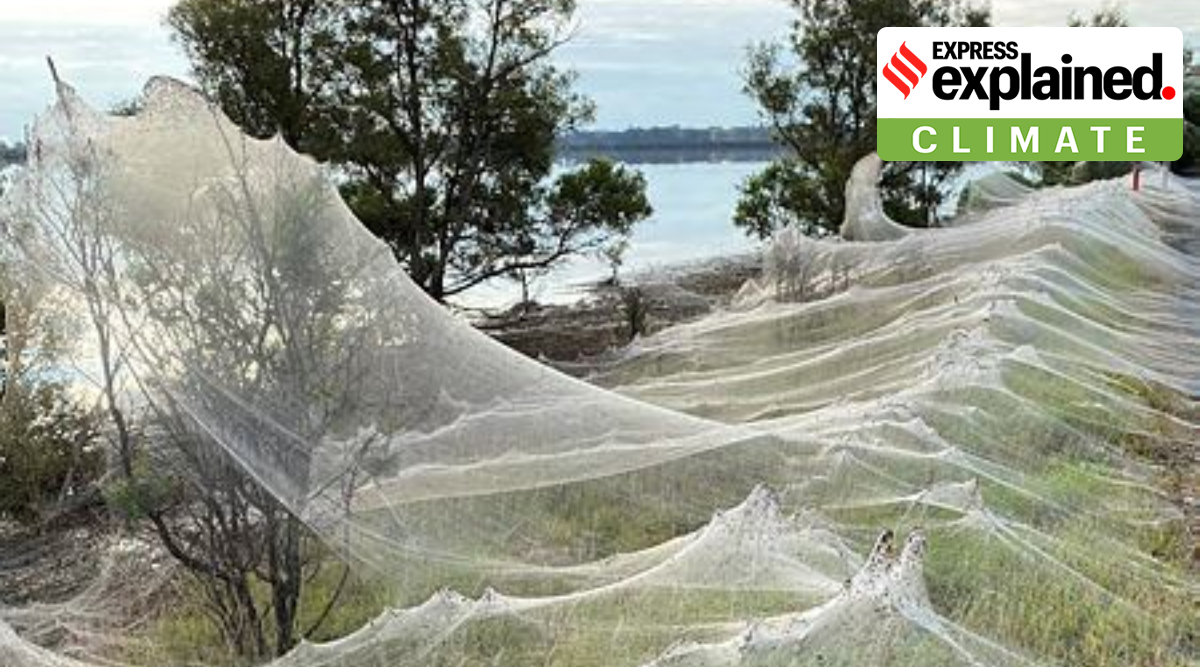Explained: Why massive spider webs have blanketed a region in Australia

After heavy rains and floods struck Australia’s southeastern state of Victoria, lakhs of spiders have spun webs stretching across trees, road signs and paddocks, creating huge “gossamer” sheets.
In the state’s Gippsland region, days of intense rainfall have caused spiders to climb to higher ground using a survival tactic called “ballooning”, in which the insects throw out silk that latches on to vegetation, allowing them to escape.
Observers have described the webbing as a single sheet crawling with small spiders, billowing like a wave.
What explains the massive spider web in Australia?
Last week, Victoria received heavy rains along with strong winds, leading to flash flooding and major damage to property.
Newsletter | Click to get the day’s best explainers in your inbox
 This led to ground-dwelling spiders throwing strands to nearby trees in an attempt to get off the ground fast. Lakhs of spiders did this at the same time, creating “gossamer” sheets covering the wetlands between the towns of Sale and Langford, which are around 8 km apart. In one area in Gippsland, a spider web covered more than a kilometre along a road, as per the BBC. The webs are expected to fade away towards the end of the week.
This led to ground-dwelling spiders throwing strands to nearby trees in an attempt to get off the ground fast. Lakhs of spiders did this at the same time, creating “gossamer” sheets covering the wetlands between the towns of Sale and Langford, which are around 8 km apart. In one area in Gippsland, a spider web covered more than a kilometre along a road, as per the BBC. The webs are expected to fade away towards the end of the week.
Victoria state generally sees this natural phenomenon during the winter, when it receives most of its rain. When this happens, spiders, which can produce a wide variety of silks, produce this kind of web which is very thin and delicate, and allows them to fly away with the breeze, sometimes as far as 100 km.
Because this ballooning silk is lighter than air, it latches on to objects such as tree tops, tall grass and road signs, allowing the spiders to climb up. As per a report in the Guardian, the spiders which lay such webs are called “vagrant hunters”, which typically live on the ground and do not build a web. Even while ballooning after a flood, each spider throws up only one thread – meaning every line in the massive web blanket seen this week is made by a different insect; their total thus being expected in the millions.
Arachnids in Australia have often turned into internet sensations. While the ballooning spiders are not dangerous to humans, some species are. Between 2000 and 2013, nearly 12,600 people were admitted to hospital because of spider bites. An episode from Peppa Pig, a British animated television series, in which a character says spiders are “very very small” and “can’t hurt you”, has been pulled off air in the country.
Recent incidents of animals wreaking havoc
Also this year, Australia’s eastern states witnessed a “mice rain”– a devastating mouse plague that has affected farmers, community members and residents. To end the crisis, the government had to authorise the use of an otherwise outlawed poison called bromadiolone.
In January last year, the South Australia state carried out a five-day culling of up to 10,000 camels, using sniper fire from helicopters. Camels in Australia, which number over 10 lakh, were first brought to the continent in the late 19th century from India, when the country’s massive interior region was first being explored. The feral camels have since threatened scarce reserves of food and water, besides damaging infrastructure and creating a hazard for drivers.

“평생 사상가. 웹 광신자. 좀비 중독자. 커뮤니케이터. 창조자. 프리랜서 여행 애호가.”
